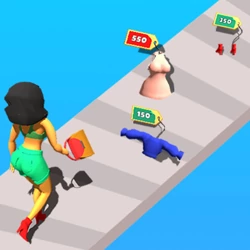Description:
I woke one morning to find an empty space on the bed where my girlfriend usually lay. I felt a pang of confusion and promptly began scouring the house, calling her name into every empty room and turning every object over in my search. However, all of my efforts proved fruitless. A cold sense of anxiety began to creep over me as her absence became more significant.It was then that a sheet of paper, ratified at the corners and hastily balanced atop our small kitchen table, caught my eye. Squinting, I read its message; a chilling warning echoing in the silence of our house, "If you ever want to lay eyes on your girlfriend again, you will need to traverse through the enchanted forest. But beware! For you are not the only mover amidst the towering trees!" The words were cryptic and unsettling, and I could not for the life of me comprehend what they meant.
Overwhelmed by an array of disparate emotions, I stood still, paralyzed from the cryptic letter's contents. Gradually, however, determination replaced dread and bewilderment. I resolved to brave this so-called 'magic forest' to save the one I held dear. Unbeknownst to me, saving my girlfriend would require more than pure courage; I would have to master a skill that was unlike anything I had tackled before - shooting bubbles.
At first, the term 'shooting bubbles' seemed nonsensical, something like a child's riddle. It was only when I met the gatekeeper of the magic forest, a cryptic character who could speak only in riddles, that it started to make sense. Shooting bubbles, it seemed, was the unique magical ability I needed to develop to thwart the darkness within the forest and rescue my girlfriend. This was no ordinary circus trick but a powerful arcane magic casting light against the roving darkness.
The journey through the mystical forest was challenging, with shooting bubbles becoming an essential tool to navigate the maze of trees. It was as though the forest responded to the bubbles, lighting the path ahead and keeping danger at bay. It was a trial of resilience, skill, and a testament to the power of love. But I faced every challenge head-on, strengthened by the hope of finding my girlfriend.
As I illuminated my path, “shooting bubbles” gaining new meaning every step I took, I understood that this was more than just a physical journey through an enchanted wood. It was a journey of self-discovery, of understanding my potential, and proving the lengths to which I would go to for the sake of love.
Instructions:
Magic: Left Click Super Magic: Hold Right Click Move: W-A-S-D or Arrow Keys Power: Hold Left Shift Health Regeneration: HWhat are Browser Games
A browser game or a "flash game" is a video game that is played via the internet using a web browser. They are mostly free-to-play and can be single-player or multiplayer.
Some browser games are also available as mobile apps, PC games, or on consoles. For users, the advantage of the browser version is not having to install the game; the browser automatically downloads the necessary content from the game's website. However, the browser version may have fewer features or inferior graphics compared to the others, which are usually native apps.
The front end of a browser game is what runs in the user's browser. It is implemented with the standard web technologies of HTML, CSS, JavaScript, and WebAssembly. In addition, WebGL enables more sophisticated graphics. On the back end, numerous server technologies can be used.
In the past, many games were created with Adobe Flash, but they can no longer be played in the major browsers, such as Google Chrome, Safari, and Firefox due to Adobe Flash being shut down on December 31, 2020. Thousands of these games have been preserved by the Flashpoint project.
When the Internet first became widely available and initial web browsers with basic HTML support were released, the earliest browser games were similar to text-based Multi-User Dungeons (MUDs), minimizing interactions to what implemented through simple browser controls but supporting online interactions with other players through a basic client–server model.[6] One of the first known examples of a browser game was Earth 2025, first released in 1995. It featured only text but allowed players to interact and form alliances with other players of the game.



